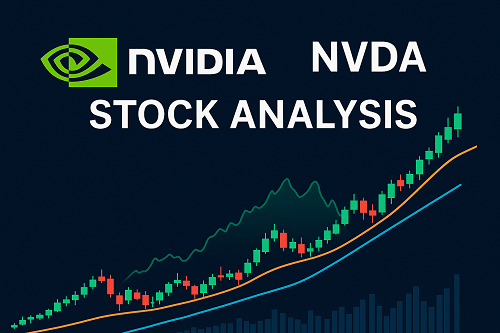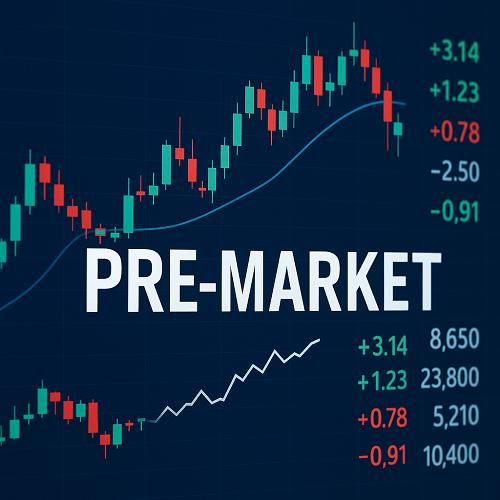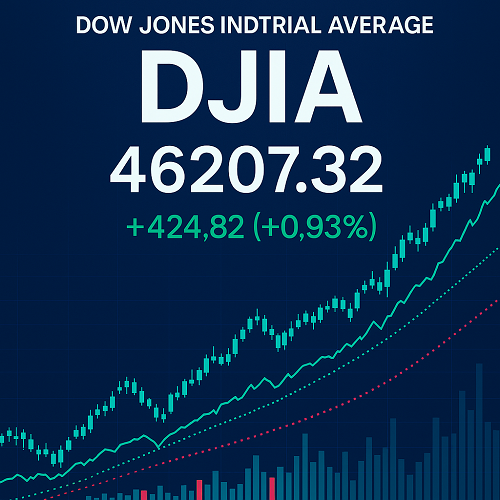Why NVDA Matters Today
NVIDIA Corporation (ticker NVDA) is now not merely a “chipmaker” — it sits at the fulcrum of the AI revolution. Its GPUs and software stack power training models, inference, data centers, autonomous systems, robotics, and more. As of mid-2025, Nvidia’s market capitalization has surged past US$4 trillion—making it one of the world’s most valuable companies. For those interested in financial markets, tracking the NVDA stock price today is crucial.
Because of its outsized positioning at multiple tech frontiers, NVDA’s stock is highly sensitive to macro shifts, regulatory risk, export controls, and sentiment swings. That makes it a compelling target for both long-term investors and active traders.
To outrank a generic quote page, this analysis goes deeper: weaving in institutional positioning, edge signals, multi-scenario valuation and tradeable setups.
Business & Competitive Moat
Understanding NVDA requires dissecting its architecture of advantages:
Fabless Design + Ecosystem
- NVIDIA is fabless: it designs GPUs and offloads manufacturing (e.g. via TSMC). This allows capital-light scaling and focus on innovation.
- Its CUDA ecosystem, drivers, libraries (cuDNN, TensorRT), and ML software form a high switching-cost moat. It’s not just hardware — it’s hardware + software.
Market Share & Customer Wins
- In AI training and inference hardware, NVIDIA is dominant. As of recent quarters, it holds an estimated ~80–90% share of AI data center GPU capacity.
- Many hyperscalers (Microsoft, Amazon, Google, Meta) are long-term customers and strategic partners.
- NVIDIA’s foray into full-stack AI infrastructure (chips + interconnect, networking, software) makes it harder for rivals to disaggregate.
Platform Strategy
- The upcoming Blackwell architecture and Rubin chips promise step-function gains in energy efficiency and throughput.
- By vertically integrating across chip, interconnect (NVLink, NVSwitch), and software, NVIDIA squeezes out differentiation.
- It is also expanding into inference edge, robotics, autonomous vehicles, and even generative AI tools.
Customer & Revenue Concentration
- A potential weak point: a few large customers account for a disproportionate share of revenue. For example, one report flagged the top two customers contributed ~39% of quarterly revenue.
- Overreliance on major clients or hyperscalers may expose it if they shift to alternative architectures.
Financial Performance & Key Metrics
Let’s break down how NVDA is performing at the numbers level.
Recent Results Snapshot
From Q2 (fiscal year 2026) results:
- Revenue: ~$46.74 billion (YoY growth ~55.6%)
- Adjusted EPS beat estimates (~$1.05 vs ~$1.01)
- Operating margins and free cash flow remain strong, but signs of margin compression in certain segments.
Growth and Profitability Metrics
| Metric | Value / Trend | Interpretation |
|---|---|---|
| Revenue Growth (5-year CAGR) | Very high (50%-plus) | Demonstrates explosive top-line scaling |
| Gross & Operating Margins | Among highest in semiconductor industry | Reflects pricing power and efficiency |
| ROIC / ROE | Elevated relative to peers | Strong capital allocation |
| Cash vs Debt | Healthy — more cash than debt in many quarters | Resilient balance sheet |
A published academic paper applies a value-investing lens to NVDA over 20 years, noting that its trajectory defies classic value metrics but that its superior risk-adjusted returns validate the premium pricing.
Segment Breakdown
Key revenue segments include:
- Data Center / AI GPUs — core driver
- Gaming / GeForce — mature but still large base
- Professional Visualization / Workstations
- Automotive / Edge / Inference
Over time, Data Center is increasing its share — meaning revenue volatility is increasingly correlated with AI investment cycles.
Growth Catalysts Driving NVDA
Why many bulls believe NVDA still has runway:
AI & LLM Demand Explosion
Next-generation LLMs and multimodal AI require exponential compute scaling — driving hyperscalers to invest heavily in GPUs, HBM memory, interconnect, and energy-efficient inference.
Blackwell / Rubin / Architecture Leap
NVIDIA’s architecture transitions (e.g. Blackwell) aim to deliver multiplex gains in performance-per-watt, reducing total cost of ownership for customers — an edge in enterprise adoption.
Edge & Inference Growth
As inference shifts to edge or hybrid cloud-edge, NVIDIA’s lighter inference chips and AI accelerators may capture new workflows beyond data centers.
4.4 Partnerships & Vertical Integration
Its alliance with OpenAI (including rumored $100B support) gives it both strategic visibility and influence over future model direction.
4.5 Government / Institutional AI Spending
Governments worldwide are accelerating AI investments, data infrastructure, and sovereign compute initiatives — providing a recurring tailwind.
Risks & Headwinds
Any balanced view must weigh possible downside scenarios:
Competition & Disintermediation
- AMD, Intel, and startups may erode parts of NVIDIA’s moat with new architectures (e.g. AI ASICs, RISC-V, AI accelerators).
- If customers decouple software layers, switching cost lowers.
Regulatory / Export Controls
U.S. export restrictions to China and emerging geopol liturgy risk cutting off key demand streams.
Valuation Bubble & Sentiment Reversal
Some analysts compare current AI exuberance to the dot-com bubble, warning of overvaluation or circular financing.
Margin Compression
As scale grows, managing power, cooling, wafer costs, memory scarcity, and yield becomes harder. Margins may shrink under pressure.
Overdependence on Key Customers
If a major buyer (e.g. Amazon, Microsoft) shifts priorities or invests internally, NVDA’s revenue could materially decline.
Valuation: Models & Scenarios
Let’s run through multiple valuation frameworks to anchor expectations.
Discounted Cash Flow (DCF) Approach
- Project FCF growth under base, bull, and bear cases (e.g. 30%, 50%, 20% growth).
- Use discount rates of 8%–12% (reflecting tech risk).
- Terminal multiple assumptions vary (e.g. 25–40x).
This yields a wide fair-value band. Depending on assumptions, some DCF models suggest NVDA is richly valued today, others imply upside if growth sustains.
Relative Multiples
- NVDA trades at extreme forward P/E multiples (50×+, depending on projections) vs peers.
- Metrics like EV/EBITDA, P/S (given hypergrowth), or PEG (price-to-earnings-to-growth) help adjust for expectations.
- Some valuation skeptics, e.g. Aswath Damodaran, estimate NVDA should trade far lower by segmenting its business.
Scenario-Based Valuation
- Bear case: AI growth slows, regulatory bottlenecks, strong competition: downside 30–50%.
- Base case: steady AI adoption, margin stability: modest multiple expansion.
- Bull case: platform dominance, new verticals, multiple rerating: 2–4× upside from current levels.
A cautious edge: to generate alpha, entering on weakness or earnings pullbacks may offer a lower-risk entry compared to catching all-time highs.
Technical Analysis & Chart Patterns
A top-tier article must layer in actionable chart-based insights.
Price Structure & Trend
- Over the past 12–24 months, NVDA has exhibited a strong uptrend channel, with periodic pullbacks serving as consolidation zones.
- Support zones often cluster near prior consolidation highs (i.e. breakouts becoming support).
- Fibonacci retracements from major moves (e.g. from prior low to high) show confluence zones around 38–61% levels as ideal re-entry zones.
Key Moving Averages & Momentum
- The 50-day and 200-day moving averages often converge or act as dynamic support.
- MACD crossovers, RSI extremes, volume spikes during breakouts or reversals flag potential entries/exits.
Patterns & Breakouts
- Look for bullish continuation patterns: flags, pennants, ascending triangles.
- Volume confirmation is crucial: a breakout should be accompanied by above-average volume.
- Beware false breakouts — manage risk via stop-loss just below breaks.
Price & Volatility Regimes
- NVDA can oscillate between trending and range-bound regimes. Use ATR (average true range) and volatility band indicators (e.g. Bollinger Bands) to detect regime shifts.
- In high volatility regimes, expect larger swings; scaling in or pyramiding may help manage exposure.
Sentiment, Flow & Positioning
Beyond fundamentals and charts, understanding market psychology, flows, and positioning offers an edge.
Options & Implied Volatility
- Monitor skew and open interest in calls vs puts. Heavy call loading in far-dated strikes may suggest optimism or hedging bets.
- Rising implied volatility into earnings or product launches prefaces directional risk.
Institutional & Whale Activity
- Track 13F filings, fund allocations, insider buys/sells. CEO Jensen Huang recently sold shares under Rule 10b5-1 plans.
- Large volume spikes outside regular patterns may signal institutional accumulation or distribution.
Social / AI Hype Cycles
- AI narratives (e.g. ChatGPT, next-gen models) drive investor sentiment. News cycles around NVIDIA, OpenAI, export controls, or breakthroughs can create momentum surges or reversals.
- Be cautious of overhyped headlines — they can cause overextensions or mean reversion.
Correlation & Macro Regimes
- NVDA’s performance sometimes correlates strongly with broader tech indices, semiconductor indices, or AI-related equities.
- Broad equity selloffs, interest rate surges, or macro shocks can drag even strong names downward.
Trading / Investment Strategies
Here are some refined, actionable strategies suited for NVDA:
Averaged / Laddered Accumulation
Use pullbacks to key support zones to build a position gradually. Don’t load all-in at highs.
Option Spreads for Asymmetric Exposure
- Call spreads (long call / short higher strike) let you capture upside with limited risk.
- Iron condors or straddles around earnings can exploit expected volatility if priced attractively.
- Use protective puts if holding a large long exposure into event risk (earnings, product announcements).
Momentum Breakout Trades
Enter on confirmed breakout above resistance with volume confirmation, using tight stops just below the breakout level.
Pyramiding into Trend
After confirmation of uptrend, add incremental lots on pullbacks within the trend. But scale out partial positions as price moves higher.
Reversion / Mean Reversion Plays
When overextended into highs (extreme RSI, parabolic move), consider short-term reversion plays, perhaps via short-term call sales or put purchases — but only with disciplined risk management.
Risk Management
- Never risk more than 1–3% of account capital on any single leg/trade.
- Use stop-loss orders or mental exits.
- Avoid overleveraging into earnings or ambiguous setups.
5-Year Forecasts & Edge Cases
Forecasting such a dynamic stock contains uncertainty, but here’s a structured outlook.
Base Scenario
NVDA continues to lead in AI compute. Over 5 years, consistent growth and moderate multiple expansion yield 2× to 3× gains from current levels.
Bull Scenario
If NVIDIA captures new verticals (e.g. robotics, embedded AI, sovereign AI infrastructure), achieves cost breakthroughs via architecture leaps, and multiple rerates, upside of 3× to 5× or more becomes plausible.
Bear / Stress Scenario
AI sentiment reversal, regulatory embargoes, or competitive disruption could drive 30–60% downside in extended bear cycles.
Key Variables to Watch
- AI adoption cycles and compute spending by Big Tech
- Export controls and US/China semiconductor geopolitics
- Material changes in margins, supply chain, and wafer scarcity
- Breakthroughs in alternative compute architectures (e.g. quantum, novel AI chips)
A prudent approach is to update forecasts annually and adjust exposure dynamically.
Conclusion
NVIDIA (NVDA) stands at a rare confluence of secular megatrends, technical dominance, and ecosystem control. While its valuation is aggressive and risks loom, the path to outsized returns remains intact—if carefully navigated. The real edge lies in combining fundamentals, technicals, sentiment, and disciplined risk control.





 XAUT-USD
XAUT-USD  AMD
AMD  MARA
MARA  SHOP
SHOP  BULL
BULL  CL=F
CL=F